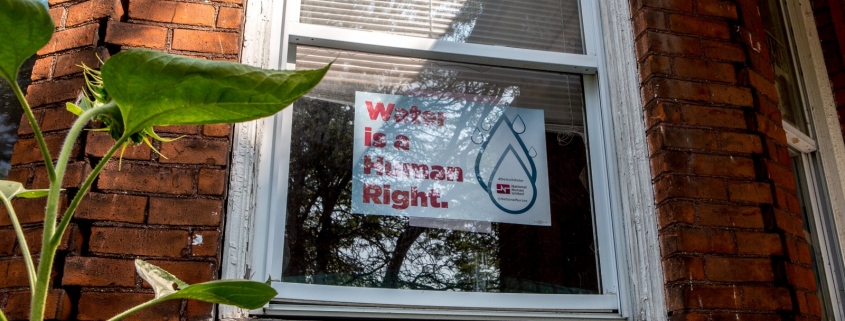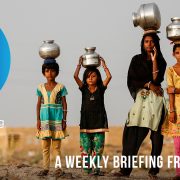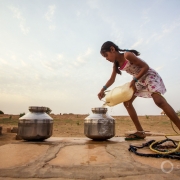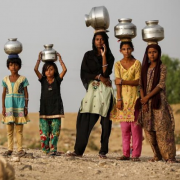What’s Up With Water – February 17, 2020
This is Eileen Wray-McCann for Circle of Blue. And this is What’s Up with Water, your “need-to-know news” of the world’s water, made possible by support from people like you.
In Australia, water levels in Sydney’s main drinking water reservoir surged to 78 percent of capacity after a week of torrential rainfall in the state of New South Wales. Inflows into the Warragamba Dam were the highest recorded in three years, and it is now nearly twice as full. Just a week ago, the dam was at only m 43 percent full. Not only did the storms revive reservoirs depleted by a severe three-year drought, the heavy rains also extinguished unprecedented bushfires that had devastated the state in recent months. But the downpours also caused flash flooding and they swept ash and debris into river catchments, polluting waterways and killing fish. ABC news reported that Sydney officials temporarily stopped using Warragamba Dam as a water source last week as a precaution against degraded water quality. The dam was returned to service on Saturday with an array of floating booms to keep debris away from vital infrastructure.
In Thailand, a lack of water is weighing on the economy. Bloomberg news reported that the effects of a deep drought are being felt most sharply in the agriculture sector. Rice exports are expected to be the smallest since 2013. Thailand is the world’s second largest rice exporter. Sugar cane and rubber tree production are also anticipated to drop. Analysts warn that if the drought extends into July, water shortages could reverberate within the industrial sector as well.
In the Gaza Strip, clean drinking water will get new funding support. The World Bank and its partners announced $117 million for water distribution pipelines, pumping stations, and storage reservoirs. These are components of a water delivery system along Gaza’s central coast that will be connected to a new desalination plant. Gaza is squeezed between the Mediterranean Sea and the Israeli state, which exerts control over much of the region’s water supply. The coastal aquifer that Gazans currently rely on is contaminated with salts and sewage. Most of the water that comes from the aquifer is unfit for human consumption, according to standards set by the World Health Organization.
In the United States, officials in two Great Lakes states are considering ways to lighten the financial burden of high water bills on low-income families. Lawyers for the Detroit City Council are drafting a resolution asking Gov. Gretchen Whitmer to declare a public health crisis and ban water shutoffs in the city. According to data from the Detroit News, Detroit’s Water and Sewerage Department disconnected water service to 23,000 properties last year because of overdue water bills. The council is expected to vote on the resolution in the next two weeks.
Meanwhile, in Ohio, the center of action is the Legislature. A Democratic lawmaker introduced a bill that would prohibit cities from using tax liens as a tool to recover overdue water bills. Liens allow the city to make money on unpaid bills by selling the right to collect that debt to outside investors. Because they add extra administrative fees and interest, liens can increase a household’s water debt by several thousand dollars. If the debt continues to go unpaid, a worst-case scenario can result in a person losing title to their home. In recognition of this financial burden, other jurisdictions have moved to ban the practice. Last year, the Maryland legislature prohibited Baltimore from using liens as a tool for collecting water bill debt.
This week, Circle of Blue looks at how North Carolina is dealing with water debt.
The cost of operating aging sewer systems is plunging some of the smallest communities in North Carolina into unmanageable debt. The state’s leadership is working to ease those financial hardships and prevent future small-system crises from emerging.
The North Carolina Water Infrastructure Authority has the power to direct state funding to these communities. At a meeting on February 12, the Infrastructure Authority approved a $150,000 emergency grant for Cliffside Sanitary District. The district is a tiny sewer provider in Rutherford County, located in the state’s Appalachian foothills.
The grant is for operational expenses such as sewer system repairs and electric bills that are beyond the limits of Cliffside’s revenue this year.
With a shrinking customer base, dwindling revenues, and decrepit pipes, Cliffside is in a precarious financial position. County officials estimate that the sewer system needs major improvements. The News & Observer puts the upgrades and repairs at about $10 million. Cliffside’s roughly 75 customers cannot manage that cost on their own.
Regulators with the state Local Government Commission intervened last September, taking control of Cliffside’s finances. The sewer district was one of two local governing bodies that the commission took over in 2019 due to an indebted sewer system. The other community was Eureka, a town of fewer than 200 people.
A bill signed by Gov. Roy Cooper last year allows the Water Infrastructure Authority to use emergency funding for the operating deficits of utilities like Cliffside that the state has taken over. Cliffside and Eureka could be the tip of the iceberg. Last year, the local Government Commission published a “watch list” of 100 towns that are financially distressed. Roughly two-thirds of the towns were placed on the list because of their sewer systems.
Demographic trends are not favorable. Many of these towns have been losing population and industry for years. Infrastructure and climate patterns are also a hurdle. Cracked sewer pipes take on a large amount of water during heavy rains. Towns have to pay to treat this water, but they get no revenue for it from customers, because customers only pay for what comes out of their faucets. Adding to the problem, North Carolina is expected to see more downpours as the climate warms.
North Carolina officials are exploring options that would prevent the need for future bailouts of other small, financially struggling utilities. These utilities might share staff and administrative resources to cut down the cost of billing. In some cases, small utilities that are not financially viable might shut down and join forces with a larger neighbor or a regional partnership.
To that end, the Infrastructure Authority also approved $50,000 grants for 10 utilities to study the feasibility of mergers and regional partnerships.
And that’s What’s Up With Water from Circle of Blue, which depends on your support for independent water news and analysis. Please visit circleofblue.org and make a difference through your tax-deductible donation.
Eileen Wray-McCann is a writer, director and narrator who co-founded Circle of Blue. During her 13 years at Interlochen Public Radio, a National Public Radio affiliate in Northern Michigan, Eileen produced and hosted regional and national programming. She’s won Telly Awards for her scriptwriting and documentary work, and her work with Circle of Blue follows many years of independent multimedia journalistic projects and a life-long love of the Great Lakes. She holds a BA and MA radio and television from the University of Detroit. Eileen is currently moonlighting as an audio archivist and enjoys traveling through time via sound.











Leave a Reply
Want to join the discussion?Feel free to contribute!